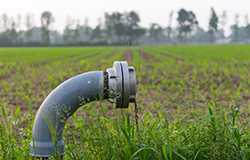Tracking Europe’s water footprint, identifying potential economic vulnerability
European mitigation and adaptation strategies in response to the increase of high impact hydrological extremes rely on both improved forecasting coupled with an accurate quantification of the likely impact. Impact assessments need to look at a wide range of issues such as: the effect on citizen safety; agricultural production; transportation; energy production; urban water supply, and ultimately, overall economic productivity. A recent study ‘Dependencies of Europe’s economy on other parts of the world in terms of water resources’, carried out as part of the EU-funded IMPREX project, contributes to the development of a comprehensive risk assessment. Based on an analysis of where the goods consumed by European citizens or used by businesses are produced, the IMPREX research finds that almost 40% of the EU’s water demand is fulfilled by countries outside Europe. Furthermore, the study identifies that some European staples such as animal feed, rice and cotton, all come from regions experiencing increasing water scarcity, presenting a potential vulnerability for the European economy. Understanding demand, as well as supply The basis for the study was the fact that commodities of international trade contain ‘virtual water’ embedded within them, as components necessary for their production. Therefore, combining knowledge about the source and flow of this virtual water, as it enters and leaves regions, can shed light on the water dependencies of economies. Perhaps the most obvious example is with agriculture-based products that are water-intensive, dependent upon water availability at various locations and stages in the production process. This makes the production vulnerable to threats such as fresh water pollution, droughts or river flow reductions. The IMPREX data mapped specific crops imported by Europe against their regions of origin, tracing instances where produce comes from regions facing degrees of water scarcity. Examples put forward being the import of cotton, rice and sugar cane from Australia and South Africa, both facing severe water scarcity. In order to calculate the ‘water footprint’ generated by the flow of the production and consumption of these commodities, IMPREX looked at three source water components referred to as green, blue and grey. The green water footprint representing precipitation water stored in soil and evaporated, transpired or incorporated by plants, relevant for agricultural, horticultural and forestry products. Blue water has been sourced from surface or groundwater resources and has either evaporated, been incorporated into a product or taken from one body of water to another, usually for irrigated agriculture, industry and domestic water use. Grey water is water that assimilates pollutants to maintain quality and safety standards. The IMPREX team were able to build a ‘Virtual Water Trade Model’ which correlates the annual global trade flows of major industrial products, crop products, livestock products to national production, for each of the green, blue and grey water footprints. The model covers the years 2006-2013, the most recent years for which data is reliably available. The study found that the EU’s production and consumption water footprints for this period were respectively, on average, 517 km3 and 600 km3 per year. Developing the vulnerability assessment framework Commenting on the results of the study, Professor Bart van den Hurk, the IMPREX project coordinator has said, ‘Right now it is more like an alert.’ Indeed, the study forms the baseline for the project’s next stage, which is to assess the actual likely impacts, and so potential vulnerability, of different European economic sectors. IMPREX will ultimately support European governments, policy-makers and private companies with their sustainable development planning, integrating the influence of population growth, increased demand for products and services, and climate change. For more information, please see: project website
Countries
Netherlands



